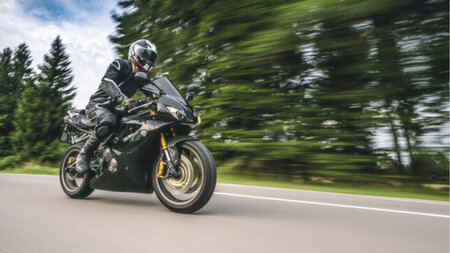Safe motorcycling
General advice and information about safe motorcycling for those just starting out and for experienced motorcyclists.
As millions of trained motorcyclists around the world prove every day, biking can be a fun, safe and enjoyable activity. Getting the right training, developing good habits and regular refresher training will help keep you, your passenger and other road users safe.

Get your motorcycle licence
Step-by-step guidance on how to get your licence and become a safe, qualified driver.
Safer motorcycling
Watch and learn why you need to become a skilled, safe motorcyclist
The importance of training
Whether you’re just starting out, returning to biking after a long absence, or a qualified motorcyclist wishing to enhance your riding skills, it’s vital to always stay safe. This will ensure that you have many enjoyable years of safe motorcycling ahead of you. Understanding the principles of safe and socially responsible riding will help you to achieve this goal.
There are four motorcycle driving licence categories, each of which has specific motorcycle training requirements.
There are four steps to obtaining a motorcycle driving licence:
- Prepare for and pass your motorcycle theory test.
- Apply for your learner permit.
- Complete Initial Basic Training – your training will depend on the category of motorcycle for which you want to obtain a licence.
- Prepare for and pass your driving test.
You can now easily manage all your driver services, tests, permits and licences online on MyRoadSafety.
Motorcycle Safety
Download 'This is your bike' - Our motorcycle safety booklet pdf | 1892 KBGuarding against complacency
With increased levels of experience and skill, seasoned motorcyclists must guard against complacency and avoid riding to the limits of their skill. Remember that on public roads you must ride within the legal speed limit paying particular attention to the prevailing road and traffic conditions.
Greater awareness of safety and better training are key to reducing deaths and injuries among motorcyclists. Safer motorcycling is a key part of our forthcoming road safety strategy 2021-2030.
Motorcycle collision statistics
Motorcyclists are over-represented in collision statistics in Ireland. They account for less than 2% of licensed vehicles but 10% of road deaths. Motorcyclists are six times more likely to be killed on Irish roads than any other road user.
Ireland is not unusual in this. In Europe the risk of dying in a road collision is 18 times higher for motorcyclists (source: European Road Safety Observatory – ERSO) than for any other road user. While annual road deaths in Europe declined over the past decade, motorcycle rider deaths increased in 13 countries.
Road Safety Key Figures 2020 pdf | 658 KBVulnerability of motorcycles
The lack of a protective shell combined with high speed means that motorbikes will always be a potentially vulnerable mode of transport. However, you can greatly reduce your risk by taking some simple precautions such as professional training, wearing the proper personal protective equipment (PPE) and ensuring that your motorcycle is properly maintained.
Motorcycle safety gear. Personal protection equipment (PPE) for motorcyclists includes helmet, gloves, jacket and trousers suitable for all weather conditions.
Steps to get qualified to ride a Motorcycle any size and motor tricycle - A
Campaigns
Ease off the throttle. This campaign asks motorcyclists to slow down and ‘ease off the throttle’ as bikers speeding is a factor in a third of motorcyclist fatal collisions.
Top tips for motorcyclists
Ensure that the safety helmet and protective clothing that you wear every time you get on your bike meets CE approval standards.
- Helmet should be a snug fit and properly fastened.
- Visor should be clean and clear.
- Jacket and trousers should give you enough protection from impact, abrasion, cold and weather conditions.
- Use approved body armour on vulnerable areas such as the back, knees, elbows, shoulders, hips and shins.
- Armour should be adjustable, so it fits snugly and does not move on impact.
- By wearing a good high-visibility jacket you make yourself more visible on the road.
- Wear approved protective gloves.
- Wear approved motorcycle boots that fit above the ankle.
- Be vigilant. Look into the far, middle and near distance, using your mirrors and checking over your shoulders (life-saver) before changing position or turning.
- Keep your distance. In poor weather conditions, always leave a bigger gap between you and the vehicle ahead.
- Be seen. Make sure your position is correct, use dipped headlights and wear high visibility clothing.
- Avoid surprising other road users. Never do anything on the road that could cause others to slow down, brake, swerve or that could startle pedestrians.
- Think like other road users. Anticipate how they might react to you and other road users.
- Read the road and ride to current road, weather and traffic conditions.
- Match your speed to the conditions and never let others dictate your pace.
- Never ride your motorcycle after consuming alcohol or drugs.
- Maintain your motorcycle properly. Regularly check petrol, oil, water, damage, electrics and tyres.
- Take training from an RSA Approved Driving Instructor (ADI).
Research shows that the four main causal factors that contribute to fatal motorcycle crashes are:
- A motorcyclist overtaking another vehicle turning right, resulting in the motorcyclist colliding head on into the side of the turning vehicle.
- A motorcyclist colliding head on with an oncoming vehicle while the motorcycle was overtaking a vehicle.
- A motorcyclist losing control while taking a corner / bend and crossing into the path of an oncoming vehicle resulting in a head on collision.
- Another vehicle (car, van, truck) turning or driving through a junction / joining a main road from a minor road and colliding with a motorcyclist.
/overtaking-when-vehicle-is-travelling-in-the-same-direction.tmb-.jpg)
-450-x-242-px/overtaking-turning-right.tmb-.jpg)
/joining_a_main_road.tmb-.jpg)
-450-x-242-px/negotiating_corners_and_bends.tmb-.jpg)